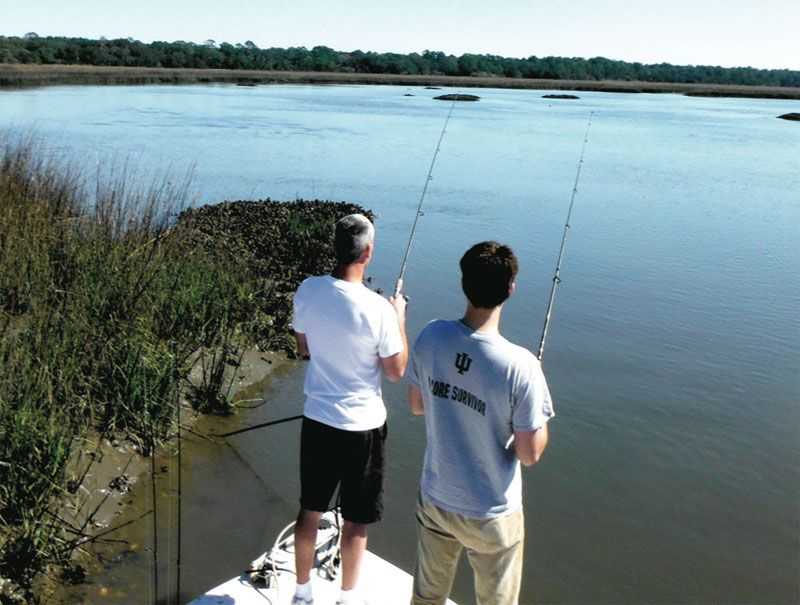Finding fish in a large body of water is no easy task especially when the water is anything but clear. Occasionally you find fish by studying the surface of the water. Swirls in the water, wakes left by moving fish, and bait fish scattering,are sure signs of fish, but so are more subtle clues such as a flock of birds hovering over the water, and slicks created by oily bait fish. Nevertheless, most of the time fish will give you no clue as to their whereabouts. It is up to the angler to learn how to read the water.
Many fisheries are not blessed with crystal clear water as in some others. In some places, such as here in Northeast Florida, the water can be compared to black coffee at best and on some days its coffee with cream and no sugar. Learning how to read the surface of the water is a must for any angler. Have you ever been out in the water on a slightly windy day and looked at the surface of the water and noticed how some of the water is choppy and some is as slick as glass? This is caused by the winds reacting to the surface and how the surface is moving. Knowing how the surface of the water is moving can indicate what is just below the surface. For example, water flowing over a shallow oyster bar might give you a rippling affect on the surface, and water upwelling from a deep hole will appear glassy at times. Reading the surface of the water is not a given, there are many variables to consider like wind speed and direction and which way the tide is flowing, just to mention a few. Studying the surface of the water is only one aspect of reading the water but it is one aspect you should take seriously if you wish to become a better angler.
Although not all fisheries possess clear water, there are attributes that can sometimes enable you to see below the surface, such as extremely low tides. This is something I have mentioned before and it is something I tell new anglers, “If you really want to study an area go there at the lowest tide.” With an average tide of four feet, you will be able to see oyster bars, tree stumps, channels, and many other fish-attracting features. However, remembering where these features are at high tide is another thing.
Reading isn’t always about the water, and the fish that live in it, sometimes it’s about the things that live around it, like birds. Birds are a great way to find fish, if you haven’t figured this out by now you haven’t been fishing long. Birds are not only good for finding game fish, but they can also tell you what kind of bait is in the area.
For example, Terns feed on small fish like anchovies or glass minnows, so I look for these birds when I’m fishing for Seatrout, Bluefish, and Spanish Mackerel. The Roseate Spoonbill and Black Skimmer feed mainly on shrimp and small crustaceans. Herons and Egret will feed on larger bait like finger mullet and mud minnows. Birds, like fish, are opportunistic and are always looking for an easy meal. I have seen Gulls flying over a school of redfish feeding on whatever the redfish left behind. I have also seen Herons walking behind a school of reds hoping they will miss something. If you are not familiar with birds, I suggest you buy a field guide to birds and get familiar. Birds are far better fishermen than we could ever hope to be.
Another way of reading the water is by studying the surrounding land. By this I mean look at the shoreline that you are fishing. Look for points that might be a good ambush lie. Predatory fish often take up lies from which they ambush there prey. Look for rocks along the shore, more than likely they will extend into the water. Shell banks are great places to catch sea trout. A docks pilings are great ambush lie. Most of the reading you will be doing when fishing will come from the shoreline. Reading the shoreline is the single most important thing when it comes to reading water. Over the years of studying the shoreline of northeast Florida, I have found that banks with dark mud that is full of pot holes (pot holes made by fiddler crabs) are great places to catch reds.
Reading the waters is something all good anglers do. It isn’t something you can get out of a book, it take years of time on the water. From knowing the lay of the land, to observing birds as they feed, it is reading these subtle clues that will make you a seasoned angler. Reading the water is what makes my job so exciting, I am always looking forward to what is on the next page. If you would like to book a charter in Northeast Florida, please give me a call at (904) 708-8915 or Email me at captdavidborries@aol.com.
[easy-social-share]
